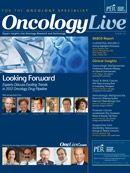Publication
Article
Oncology Live®
5 Questions for Yuri Lazebnik, PhD
Author(s):
Dr. Yuri Lazebnik's research focuses on how cells become cancerous, how cancer cells evolve, and how they can be killed selectively.
Yuri Lazebnik, PhD
Professor and Cancer Cell Biologist
Cold Spring Harbor Laboratory
Long Island, NY
Yuri Lazebnik, PhD, is a professor and cancer cell biologist at Cold Spring Harbor Laboratory, Long Island, New York. His research focuses on how cells become cancerous, how cancer cells evolve, and how they can be killed selectively. The main “Pathways” article in this month’s OncologyLive touches on the differing opinions on the hallmarks of cancer. In this Q&A, Lazebnik provides another view of the role of the hallmarks in our present and future understanding of cancer.
1
What are the hallmarks of cancer, and do you feel that they hold true today?
Pathology textbooks still suggest that the hallmarks of cancer are the ability of the tumors to invade and metastasize. Indeed, without these features, solid cancers would behave as benign tumors, which are usually harmless because they are self-contained and thus can be excised completely, even if these tumors grow fast and big, avoid apoptosis, and are self-sufficient for growth factors. The high incidence of cancer mortality might be explained by the fact that the ability to metastasize is still one of the most poorly understood features of cancer. So, I find the textbook definition both convincing and instructive.
2
What are your thoughts on the newer hallmarks that have been suggested in more recent research? Should these form part of the main hallmarks of cancer, or are they more likely to be sub-events of the original hallmarks?
The concepts added in the anniversary paper as hallmarks or sub-hallmarks, such as genomic instability, abnormal energy metabolism and evasion of the immune system, were proposed a century ago and thus can be considered as new only on the historical time scale. Hopefully, modern research will tell us how these intriguing features relate to the abilities to invade and metastasize, and will help to cure or prevent cancer.
3
How has the concept of cancer hallmarks driven new research and targeted therapies?
Two million published studies on cancer have barely made a dent in the overall cancer mortality, suggestive of a conceptual impasse. By lucidly articulating pre-existing concepts, the hallmarks article offered comforting clarity to a research field that has been befuddled by the failure of such an astronomical effort.
However, the concern is that a set of approved hallmarks implies a hierarchy of approved research directions. While this greatly facilitates the distribution of research funds, it might not be the best solution in a situation that cries for conceptually new ideas, since such ideas tend to be initially dismissed because they challenge the consensus.
For example, would the ideas that human papillomavirus and hepatitis B virus cause cancer qualify as hallmark-driven research at the time when these viruses were considered unrelated to cancer?
4
In your opinion, what has been the biggest success story in targeting cancer hallmarks?
Although the underlying research and clinical trials were done before the ability of cancer to avoid immune destruction was approved as an “enabling hallmark,” my favorite example is the anti-CTLA-4 immunotherapy, which substantially increases overall survival for patients with advanced melanoma and was recently approved by the FDA [Yervoy (ipilimumab), Bristol-Myers Squibb].
5
What are your thoughts on the future of hallmarks-based research?
The concern for the future is that dividing research as hallmark-based and non-hallmark-based might not be the best idea, even if the hallmarks are genuine. I share the view that the answer to what is cancer will be unexpected, either because it will reveal a completely new area of biology, like RNAi [RNA interference], or because it will point to something familiar, yet overlooked. If this view is correct, then creating and maintaining conditions in which ideas that differ from the consensus can be developed might be what will finally make cancer become one more disease that used to have no cure.










